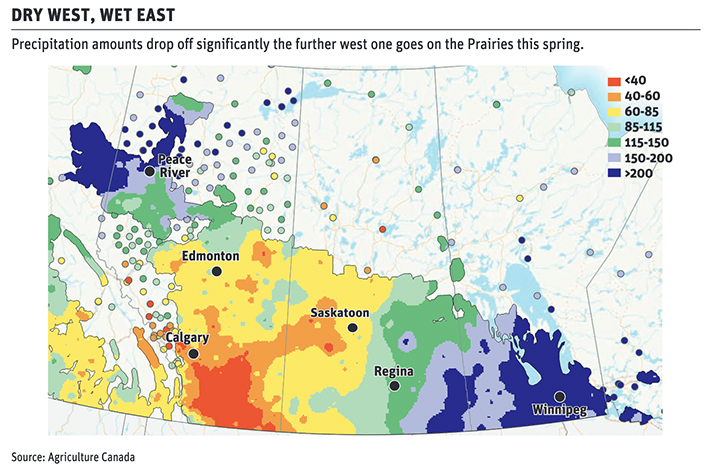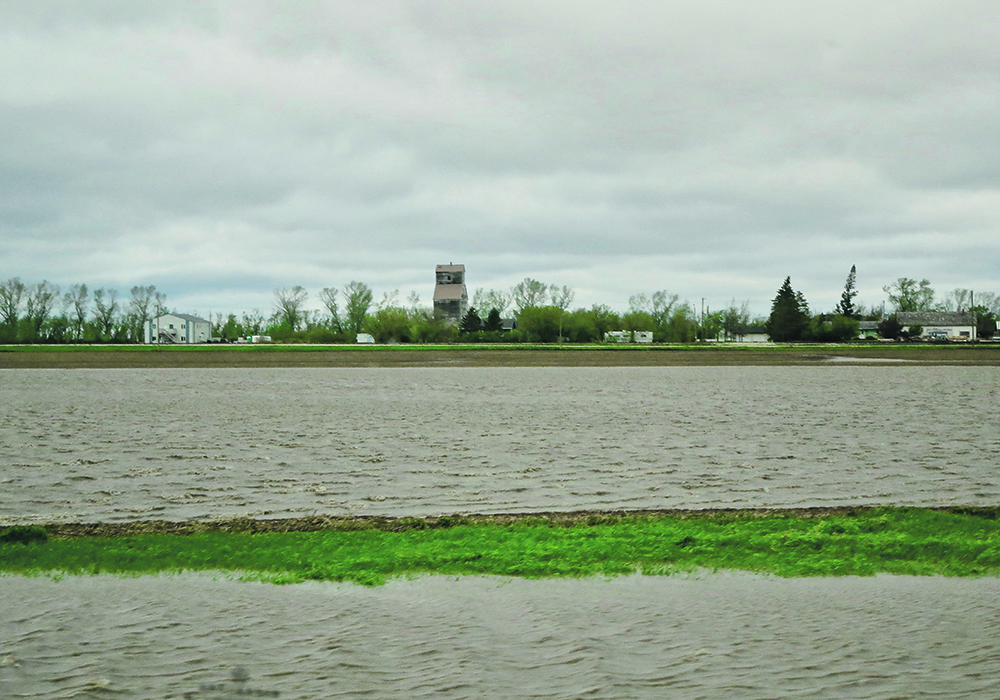The quickest thing to evaporate on the eastern Prairies this spring has been farmers’ seeding plans.
On many farms in southeastern Saskatchewan and most of Manitoba, farmers are engaged in a great switcheroo from one crop to another and one variety to the next as they wrestle with wet fields, expiring crop insurance deadlines and low seed stocks.
“We’re constantly, constantly changing, multiple times a day,” said Calvin Penner, a farmer in Manitoba’s Red River Valley at Elm Creek.
“We don’t have the seed (for preferred crops and varieties.) I’ll tell you what we’ve seeded five minutes after we’ve done it.”
The eastern Prairies have been hit by several Colorado-low weather systems that have brought a blizzard and multiple heavy rainstorms. The weather has also been much cooler than usual. Occasional showers have kept fields too wet to seed in some areas.
Overland flooding has hit much of the Red River Valley, as well as other areas with overflowing rivers or limited drainage.
Seeding is weeks late for most farmers. For many, that has meant reducing or reconsidering the big-yield crops that suck in the heat that central and eastern Manitoba usually receives over a growing season.
Corn and soybeans need lots of time and heat, so some farmers have switched to other crops like canola and cereals. However, crop insurance calculations are complicating the picture as earlier seeded and later seeded crops can reduce average yields.
“We’ve seen strategies of dropping peas in favour of more cereals, strategies of dropping cereals in favour of more canola, and now that guys are up against crop insurance deadlines, (farmers are considering) dropping soybeans and maybe picking up oats and peas,” said Eric McLean, a seed grower and retailer in Oak River, Man., on June 2.
“It’s been quite a boomerang effect.”
Farmers are scrambling to find the seed they need as parts of Plan B, C or D, with seed dealers scrambling on the other side to figure out what stocks they’ve got.
Some bin bottom stocks are coming to light, while some farmers with saturated fields are now returning seed or cancelling orders.
“We’re trying to accommodate everybody as best we can. Fortunately, we had some extra barley, oats and wheat,” said McLean.
“We had (seed such as peas) sold out and we were sitting on them for so long that we’ve had some free up in the end and now we don’t know whether they will be sold or not.”
Penner said he found some canaryseed but has no idea what variety it is.
“The guy said it was the itchy variety,” he joked.
Within crops there has been much switching from variety to variety as the growing season grows shorter day by delayed day. Longer season wheat acres are being switched into shorter season wheat varieties.
Many farmers are considering putting in more barley acres, which might be a good play not just for feed, but also for the malting barley market, said Neil Townsend of FarmLink Marketing.
“The spread between malt and feed had widened,” said Townsend, noting the impact of the Ukraine war on global malt barley availability.
“If we get some adverse weather, we could run the risk of having a shortage of malting barley.”
Ukrainian stocks of malting barley might not only be smaller than expected, but stocks might be impossible to get through Ukrainian ports if the war continues and missiles and drone strikes make ship operators avoid the Black Sea.

Sunflowers, too, are a Ukrainian crop that also grows on the eastern Prairies, and their world supplies are also in question due to the war. Mature sunflowers also have an admirable ability to survive well into the winter months and even into the following spring if they can’t be harvested in good time.
“Farmers can take advantage of that,” said Townsend.
Crop switching might not be as big a phenomenon as many now believe, Townsend said, because of the combination of low seed stocks and better weather predicted for the first couple of weeks of June.
The biggest impact might be in lower overall acres seeded in the wet zone.
“There are a lot of low spots and sloughs that just aren’t going to get planted,” said Townsend.
McLean feels fortunate to be farming in an area where water drains well.
“We’re blessed with topography here,” said McLean.
“Our high ground and drainage mean everything gets going easier here.”
For Penner, on land he describes as “flat-as-a-plate,” another production challenge looms the second he finishes seeding whatever seed he can find the seed to put in.
“When do we get out there and spray on muddy fields,” he said.
“It means more weed pressure.”
















